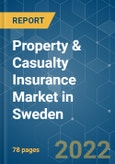Key Highlights
- Property & Casualty Insurance Market in Sweden is estimated to grow at a CAGR of approximately 5% during the forecast period.
- Every year Swedish insurance companies pay out large sums in pensions and compensation for claims. This creates financial protection for both households and businesses. The Swedish insurance industry consists of about 300 companies that together employ more than 21,000 people and invest more than SEK 4,500 billion in the Swedish and global economy. For non-life insurance, premium income amounted to a total of more than SEK 88 billion in 2018, of which about SEK 18 billion was paid by companies and SEK 70 billion by households.
- Insurance companies’ total assets were valued at SEK 998 billion at the end of 2018, a decrease of SEK 55 billion compared with the previous year. National non-life insurance companies’ net premiums written amounted to SEK 78 billion at the end of 2018, an increase of SEK 12 billion compared with 2017. Total assets of national non-life insurance companies amounted to SEK 514 billion, a decrease of SEK 7 billion compared with 2017. Results amounted to minus SEK 4 billion, which can be compared with the results of minus SEK 3 billion a year ago. Larger local non-life insurance companies reported net premiums written of about SEK 22 billion in 2018. The balance sheet total was SEK 116 billion, approximately SEK 8 billion more than the previous year. Results amounted to SEK 554 million, an increase of SEK 547 million compared with the previous year.
Key Market Trends
Non-Life Insurance premium is the highest in insurance sector:
The highest non-life insurance premium income in Sweden as of third quarter 2019 came from motor vehicle insurance and amounted to 31.3 billion Swedish kronor. It was followed by corporate and property insurance, which was 19.5 billion Swedish kronor. Many insurance policies compensate households for damages on homes and houses, boats, cars and other vehicles. Vehicle insurance is the most common of these policies. At the end of 2018, there were almost 5.1 million private cars and just over 3 million other insured motor vehicles. Home insurance and homeowner insurance are also common, Homeowner insurance policies do not only cover costs of damages under the standard home insurance policy, but also function as financial protection against damages that can affect the property itself. In 2018, the number of home insurance policies was more than 3.3 million and the number of homeowner insurance policies was 1.8 million.
Fintech adoption in Sweden:
Fintech adoption rates in 64% in Sweden, Insurtech is trending in the insurance industry. Insurance is designed to make enrolling in and managing your insurance policy as easy and technologically advanced as possible. The insurance industry is amid a digital transformation, with AI being employed in areas as diverse as underwriting and claims, customer service chatbots and risk assessments. AI can expedite processes and is helping refresh a historically ‘traditional’ sector. Insurtech reduces the cost and can provide better service to the customers.
Competitive Landscape
The report covers the major players operating in the Property & Casualty Insurance Market in Sweden. The market is consolidated, major market share is captured by few market players. The prominent players of property and casualty Insurance market in Sweden are Folksam Ömsesidig Sakförsäkring, If Skadeförsäkring AB (publ), Länsförsäkringar Skåne - Ömsesidigt.
Additional Benefits:
- The market estimate (ME) sheet in Excel format
- 3 months of analyst support
This product will be delivered within 2 business days.








